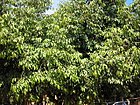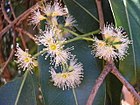Note: This is a project under development. The articles on this wiki are just being initiated and broadly incomplete. You can Help creating new pages.
Difference between revisions of "Syzygium cumini - Jambu, Malabar plum"
(→External Links) |
(→External Links) |
||
| Line 91: | Line 91: | ||
[[Category:Herbs]] | [[Category:Herbs]] | ||
[[Category:Ayurvedic herbs that don't have seed photos]] | [[Category:Ayurvedic herbs that don't have seed photos]] | ||
| + | [[Category:Myrtaceae]] | ||
Revision as of 12:33, 27 May 2019
Syzygium cumini is an evergreen tropical tree in the flowering plant family Myrtaceae. Syzygium cumini is native to the Indian Subcontinent and adjoining regions of Southeast Asia.
Contents
- 1 Uses
- 2 Parts Used
- 3 Chemical Composition
- 4 Common names
- 5 Properties
- 6 Habit
- 7 Identification
- 8 List of Ayurvedic medicine in which the herb is used
- 9 Where to get the saplings
- 10 Mode of Propagation
- 11 How to plant/cultivate
- 12 Commonly seen growing in areas
- 13 Photo Gallery
- 14 References
- 15 External Links
Uses
Diabetes, Dysentery, Snakebites, Hyperglycaemia, Glycosuria, Wounds, Irregular menstruation, Mouth ulcers, Diarrhoea
Parts Used
Chemical Composition
Total phenolics, anthocyanins and flavonoid contents of pulp, respectively. Kernel and seed coat contained total phenolics respectively.[1]
Common names
| Language | Common name |
|---|---|
| Kannada | Jambunerale |
| Hindi | Jamun |
| Malayalam | |
| Tamil | Nagai |
| Telugu | |
| Marathi | NA |
| Gujarathi | NA |
| Punjabi | NA |
| Kashmiri | NA |
| Sanskrit | |
| English | Java plum, Jamun |
Properties
Reference: Dravya - Substance, Rasa - Taste, Guna - Qualities, Veerya - Potency, Vipaka - Post-digesion effect, Karma - Pharmacological activity, Prabhava - Therepeutics.
Dravya
Rasa
Tikta (Bitter), Kashaya (Astringent)
Guna
Laghu (Light), Ruksha (Dry), Tikshna (Sharp)
Veerya
Ushna (Hot)
Vipaka
Katu (Pungent)
Karma
Kapha, Vata
Prabhava
Habit
Identification
Leaf
| Kind | Shape | Feature |
|---|---|---|
| Simple | The leaves are turpentine smell, and are opposite, 5-25 cm long, 2.5-10 cm wide, oblong-oval or elliptic, blunt or tapering to a point at the apex |
Flower
| Type | Size | Color and composition | Stamen | More information |
|---|---|---|---|---|
| Unisexual | 2.5-10 cm | white, rose-pink | 5-20 | these are fragrant and appear in clusters 2.5-10 cm long, each being 1.25 cm wide and 2.5 cm long |
Fruit
| Type | Size | Mass | Appearance | Seeds | More information |
|---|---|---|---|---|---|
| oblong | 1.25-5 cm long | The fruit is usually astringent, sometimes unpalatably so, and the flavour varies from acid to fairly sweet | With hooked hairs | 2-5 | {{{6}}} |
Other features
List of Ayurvedic medicine in which the herb is used
- Vishatinduka Taila as root juice extract
Where to get the saplings
Mode of Propagation
How to plant/cultivate
A plant of the tropics and subtropics, where it is found at elevations up to 2,000 metres. It grows best in areas where annual daytime temperatures are within the range 20 - 32°c, but can tolerate 12 - 48°c[3]
Commonly seen growing in areas
Tropical areas, Subtropical forest areas, wet to fairly dry areas.
Photo Gallery
References
External Links
- Ayurvedic Herbs known to be helpful to treat Diabetes
- Ayurvedic Herbs known to be helpful to treat Dysentery
- Ayurvedic Herbs known to be helpful to treat Snakebites
- Ayurvedic Herbs known to be helpful to treat Hyperglycaemia
- Ayurvedic Herbs known to be helpful to treat Glycosuria
- Ayurvedic Herbs known to be helpful to treat Wounds
- Ayurvedic Herbs known to be helpful to treat Irregular menstruation
- Ayurvedic Herbs known to be helpful to treat Mouth ulcers
- Ayurvedic Herbs known to be helpful to treat Diarrhoea
- Herbs with Fruits used in medicine
- Herbs with common name in Kannada
- Herbs with common name in Hindi
- Herbs with common name in Tamil
- Herbs with common name in English
- Habit - Evergreen shrub
- Index of Plants which can be propagated by Seeds
- Index of Plants which can be propagated by Cuttings
- Herbs that are commonly seen in the region of Tropical areas
- Herbs that are commonly seen in the region of Subtropical forest areas
- Herbs that are commonly seen in the region of wet to fairly dry areas
- Herbs
- Ayurvedic herbs that don't have seed photos
- Myrtaceae









